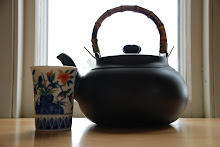
It was not surprising that I bought a loaf of brioche after having read Amanda Hesser's piece on the popover, brioche's muffin-like cousin. The aroma of baking from a neighborhood breadshop inexorably pulled me inside its humble storefront; several minutes later, I was happily in possession of a loaf of brioche of considerable heft.
I am partial to eggy desserts, including eggy breads. Even a recent encounter with almost stale challah bread did not daunt me; the telltale faint yellow hue of the bread reassured me that its rich egg-nature would be able to override any lack of freshness on its part.
As I prepared a slice of brioche for myself, I decided on the Jade Oolong for my tea. This tea, from the mountains of Taiwan, is less oxidized than many other oolongs and thus imparts a lighter flavor akin to those of the green teas; more heavily oxidized oolongs can taste almost like black teas with their assertive and robust flavors.

The Jade Oolong's leaves are tightly coiled and darkly green, its appearance and roasty aroma piquing our black cat's interest. Using fully boiled water, I brewed the tea in the gaiwan and watched the leaves unfurl in the green-golden liquor. The first sip was wonderfully floral and I felt transported to a vernal flower garden of gardenias.
The first taste of the still warm brioche likewise did not disappoint. Eggy delight had me falling into a reverie concerning the baba au rhum I had first discovered as a sixteen year-old traipsing the streets of Paris while staying at my cousins' home there. Of course, the ubiquitous boulangerie/patisserie had to be located below their apartment and it tantalized me everyday with its aroma as I passed it on my way to the nearby Metro station. I succumbed at last when hunger not sated by baguette and Nutella drove me inside the patisserie and I ended up choosing a rather bulbous looking pastry, lured in part by the toothsome candied cherry surrounded by Chantilly cream atop the whole affair. This was indeed the baba (its droll appellation, meaning old lady in Polish, has always amused me) and the first bite revealed a wonderful sponginess suffused with the slightly bitter sweetness of rum, made more decadent by Chantilly and little nuggets of bright colored candied fruits.

After having had the fourth infusion of the Jade Oolong (oolongs can actually undergo up to eight infusions without losing their taste) with the sun setting, I found myself floating somewhere in the 19th arrondissement, searching for my baba.




2 comments:
Cha Sen,
I love it when tea enthusiasts get bitten by the oolong bug. This is such a flavorful class of tea and one that provides a clear example of the importance that terroir ( place ) brings to bear on tea manufacturing styles. Chinese tea men we have met on our tea travels have told us that oolongs are the most difficult teas to produce. Once one becomes familiar with the wealth of styles made, it is easy to understand why. Happy Drinking !
Mary Lou
www.TeaTrekker.com
Mary Lou,
I certainly do appreciate the complexity of oolongs' flavors and I am not surprised that a lot of work and skill go into producing them.
Your latest book is a great fount of information, by the way and a pleasure to peruse. Thanks for stopping by.
Post a Comment